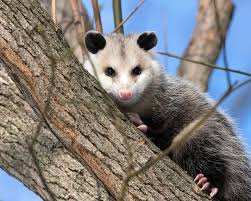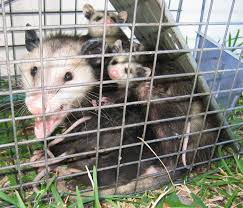Possums
Possums are protected wildlife under the
Nature Conservation Act 2014 and it is illegal for an unauthorised person to
trap or harm them. If you have tried to exclude a possum from your house but
have had no success, contact a licensed pest control company to trap the
possum, complete the exclusion work and re-release the possum on site.
Normally possums make their homes in tree
hollows but if there aren’t any they will use any suitable dark place – and the
space between the ceiling and roof of a house is a great spot. This is when
possums can create havoc and many sleepless nights in your home.
Blocking the entry is the only way to
guarantee that the possum will not return. If the possum is removed by
trapping, its home site becomes vacant, ready for another possum to move in and
the problem continues. Also, possums are strongly attached to their home site
and will return to it over distances of up to five kilometres.
The Environment website provides
information on living with possums, including:
their habits;
determining if possums have moved into your
house – and how to block them out;
their removal by licensed pest control
companies.

How To Get Rid of Possums
Many homeowners have found possums taking
up residence in their attic, basement, garage or outbuilding much to their
displeasure. The strong scent, urine and feces left behind by possums make them
undesirable house guests. Often mistaken for “large, white rats”
possums are generally harmless, preferring to runaway if possible or “playing
possum” if need be.
How do I prevent possums from becoming a
pest on my property?
Possums are always searching for a free
meal. To prevent possums from getting a free meal from you, all outdoor trash
cans should have tight fitting lids and outdoor pet food dishes should be
removed at the end of every meal. Make sure all pet doors are secured each
night, as possums have been known to enter homes to eat from indoor pet dishes.
Make sure possible entry points on the
outside of your home have been secured. Check attic vents, chimney caps, loose
fitting basement doors and broken windows. Use Stuf-Fit Copper mesh and Pur
Black Foam to help seal any holes or gaps that could allow access. (Please read
the Rodent Exclusion article for detailed tips and products to help make your
home pest proof).
Possum-proof your yard. Get rid of any
unnecessary debris such as fallen trees, deep leaf litter, unused cars or lawn
equipment. Keep grass cut short and trim bushes up away from the soil to get
rid of possible harborages. Trim tree branches that touch or hang over your
home. Eliminate any accessible areas under sheds, outbuildings or porches by
filling it in with rocks or blocking entry with hardware cloth.
Repellent products seem to have little to
no effect on possums and must be applied in high concentrations, often. The
smell from these repellents usually is very strong and the repellents
themselves can be quite expensive.

How can I live happily with the possums on
my property?
Brushtail and ringtail possums are both
native marsupial species that have adapted well to urbanisation and are
commonly found dwelling in Australian gardens.
Ringtail possums are a social species that build nests of bark and
leaves called ‘drays’ in which they usually dwell as a family. Brushtail possums are larger, more
territorial possums that usually reside in tree hollows. Both species of possum may occasionally take
shelter in the roofs of houses.
Many households are fortunate to share
their property with one or more possums however they can become a nuisance if
they nest in roof spaces. If you have
possums residing in your roof you should provide them with an alternative home
before attempting to evict them
The key steps are:
Place a nest box in a sheltered area of
your property
If possible, locate the possum’s nest
inside your roof and place this in the new possum-house to encourage the possum
to move in. You can also put fruit near the house (half an apple or banana) to
encourage investigation of the possum-house.
Take action to make the roof space
unattractive to the possum. This can be done by spreading quassia chips in the
roof space (alternatively place blocks of camphor in the roof cavity). Place a
light in the roof cavity and keep it switched on.
When the possum has relocated to its new
home, locate their entry point to your roof space and block off access. Make sure none of the possums or any of their
babies are in your roof before blocking off access.
Prune any tree branches that give the
possums access to your roof
If these steps are unsuccessful and you
need further assistance to remove and relocate the possums you will need to
check the legal requirements for possum trapping with your state or territory
government (see below). In some states and territories a license or permit is
required.
Should I Get Rid of That Possum Carcass
Myself, or No?
Q: What is the proper course of action for
a young Texan of questionable self-reliance when a possum decides to crawl
under her house, depart the earthly realm, and begin stinking to high heaven?
Do you recommend the DIY method or calling in the professionals? The favor of a
timely response would be greatly appreciated.
A: is not short on scrabbling critters. In
addition to plentiful possums, there are also raccoons, rabbits, badgers,
armadillos, skunks, squirrels, beavers, and porcupines, among many, many
others. But it’s always the possums, and sometimes the raccoons, and
occasionally the skunks, that seem to choose crawl spaces beneath the homes of
undeserving Texans in which to expire.
No matter the specific creature, once this
happens and the decomposition process ensues, it doesn’t take long for it to
become pungently evident that there is a real problem at hand. At first, there
is just a slight whiff of trouble. A hint. A homeowner might arrive from a hard
day’s work, open the front door, and then, on the way to the fridge for the
customary end-of-the-workday libation, pass through a faint odor that was not
there when she left the house that morning
It’s dismissed as the stink of a full
trashcan or, perhaps, flatulence from old Spot. But then, while the coffee is
brewing the next morning, it hits you again. “Where is that smell coming from”
you ask yourself? “Oh, well,” you say on the way out the door.
Very soon, though, within a day or so of
that first trace of stench, the smell becomes unmistakable. When death comes a
knocking, it does so with a fairly rapid crescendo. Tap-tap. Knock-knock-knock.
Pound. Pound. Pound. Pound. Bam! Once the unsettling realization is made that
something in your very immediate vicinity has croaked, and that the godawful
smell shows no signs of dissipation, the harried race to find the source is on
Cluttered closets are checked. So are
crowded cabinets, seldom used guest bedrooms, and the attic. Everywhere. “Could
it be under the house,” you wonder? And then, as you approach the access point,
it hits you like a carcass-filled dump truck. Sound familiar?
Backyard trapping
Trapping in your backyard has loads of
benefits. It can help get rid of rats from your compost bin, save your roses
and fruit trees from possums, but most importantly it can make your garden a
safe place for our unique native wildlife to live and feed.
We have roughly estimated that having a
trap in every 5th urban backyard is enough to create a safe environment for our
native wildlife to flourish. Whatever your reason for getting involved, we want
to help you get started in the most efficient, effective and humane way
possible.
Identify what predators you have
It’s important to know what predators
you’re targeting to ensure you use the right bait and trap. There are three
easy ways to find out
1. Look for any signs of predator activity
eg poo or teeth marks on fruit. is a great website for identifying pest poo if
you aren’t too sure!
2. Teeth marks left on chew cards can help
identify exactly which predators are paying you a visit. They also tell you
where in your backyard the predators are visiting and good places to put a
trap. You can buy packs of chew cards from our shop.
3. Tracking tunnels are another great way
to identify predators. The predator walks through ink on a pad, leaving clear
footprints you can use for identification.
Get a suitable trap
Once you know which predator you’re dealing
with, it’s time to select your trap. Follow our best practice guide to find out
what trap you’ll need. All the traps we sell are humane and meet NAWAC
(National Animal Welfare Advisory Committee) standards.